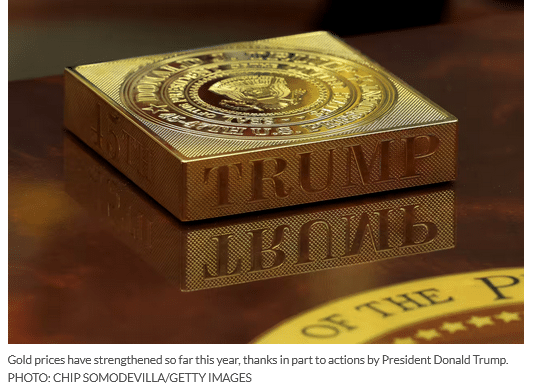
The past six months may seem like a blur, but a clear theme of President Donald Trump’s return to the White House is that it’s been good for the gold market.
While it has been nearly three months since gold climbed past $3,500 an ounce to its highest price on record, five key factors to emerge since the start of Trump’s second term in office are likely to support prices in the months ahead.
They might even prove that the precious metal is becoming a core asset class in investors’ portfolio playbook.
Gold remains a standout asset class as the market heads into the third quarter, with the metal offering “both a potential hedge against geopolitical chaos and an escape from fiat-currency erosion,” said David Miller, co-founder and chief investment officer at Catalyst Funds.
The first key factor supporting gold is demand from central banks, which shows reduced confidence in the power of the U.S. dollar.
Central-bank demand is surging, with BRICS nations, particularly China and India, accelerating their accumulation of gold reserves “as part of broader de-dollarization strategies,” Miller said in emailed commentary.
Official gold holdings by the People’s Bank of China, that country’s central bank, have climbed for eight months in a row, according to a report released Wednesday by the World Gold Council.
Trump’s threatened and imposed tariffs on countries across the globe have sped up the “process of de-dollarization,” said David Russell, global head of market strategy at TradeStation. De-dollarization refers to efforts by some countries to reduce reliance on the U.S. dollar as a reserve currency.
“Trade is becoming less dependent on the U.S. as an end-market and less dependent on the U.S. dollar. It’s becoming more like the 19th century and less like the era following [World War I and World War II],” Russell said in emailed commentary.
“This return to the older model has created a structural demand for gold after decades of neglect,” he said. “Fiat currencies are in decline.”
A decrease in credit quality among developed governments, such as the U.S., is also a major concern for the markets, Russell said.
“We have lost AAA status at the three top rating agencies as deficits mount and the crunch of unfunded liabilities like Social Security approaches,” he said, referring in part to Moody’s move in May to lower its top credit ratings for the U.S. “After decades of kicking the can down the road, we’re running out of road.”
That said, trade policy represents a third factor influencing gold. “Wide budget deficits or increased tariffs,” which reduce demand for Treasurys, both support bullion prices, said Russell.
And with yields on 2-year and 10-year Treasurys down year to date and real rates pressured by inflation, “the opportunity cost of holding gold is falling,” said Miller at Catalyst Funds. That leads to a fourth potentially supportive factor for gold — a revival in investor interest in gold exchange-traded funds and alternatives.

During the first half of this year, global physically backed gold ETFs saw inflows of $38 billion to mark the strongest semiannual performance since the first half of 2020, according to the World Gold Council.
And finally, on a technical level, gold prices held their ground above $3,250 an ounce for much of June, Miller said.
That shows signs of an “upward breakout as volatility returns to equity markets,” he said. Gold for August delivery settled Wednesday at $3,359.10 an ounce.
‘Gold isn’t just a crisis hedge — it’s becoming a core asset class in the modern portfolio playbook.’ — David Miller, Catalyst Funds
The current macroeconomic environment “justifies a meaningful allocation to gold and gold-related strategies,” Miller said.
“The combination of fragile equity sentiment, uncertain policy direction and structural macro headwinds reinforces our view: Gold isn’t just a crisis hedge — it’s becoming a core asset class in the modern portfolio playbook,” he said.
Read the full article HERE.


